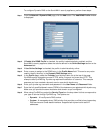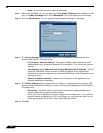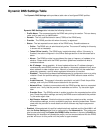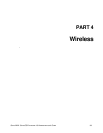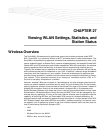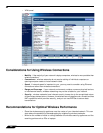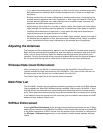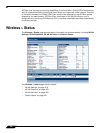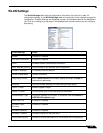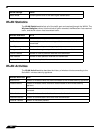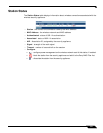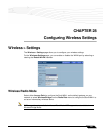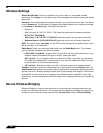
Wireless Overview
317
SonicOS Enhanced 4.0 Administrator Guide
• Try to place the wireless security appliance in a direct line with other wireless components.
Best performance is achieved when wireless components are in direct line of sight with
each other.
• Building construction can make a difference on wireless performance. Avoid placing the
wireless security appliance near walls, fireplaces, or other large solid objects. Placing the
wireless security appliance near metal objects such as computer cases, monitors, and
appliances can affect performance of the unit.
• Metal framing, UV window film, concrete or masonry walls, and metallic paint can reduce
signal strength if the wireless security appliance is installed near these types of materials.
• Installing the wireless security appliance in a high place can help avoid obstacles and
improve performance for upper stories of a building.
• Neighboring wireless networks and devices can affect signal strength, speed, and range of
the wireless security appliance. Also, devices such as cordless phones, radios, microwave
ovens, and televisions may cause interference on the wireless security appliance.
Adjusting the Antennas
The antennas on the wireless security appliance can be adjusted for the best radio reception.
Begin with the antennas pointing straight up, and then adjust as necessary. Note that certain
areas, such as the area directly below the wireless security appliance, get relatively poor
reception. Pointing the antenna directly at another wireless device does not improve reception.
Do not place the antennas next to metal doors or walls as this can cause interference.
Wireless Node Count Enforcement
Users connecting to the WLAN or connecting through the SonicWALL GroupVPN are not
counted towards the node enforcement on the SonicWALL. Only users on the LAN and non-
Wireless zones on the Opt port are counted towards the node limit.
The Station Status table lists all the wireless nodes connected.
MAC Filter List
The SonicWALL wireless security appliance networking protocol provides native MAC address
filtering capabilities. When MAC address filtering is enabled, filtering occurs at the 802.11 layer,
wireless clients are prevented from authenticating and associating with the wireless access
point. Since data communications cannot occur without authentication and association, access
to the network cannot be granted until the client has given the network administrator the MAC
address of their wireless network card.
WiFiSec Enforcement
Enabling WiFiSec Enforcement on the wireless security appliance enforces the use of IPsec-
based VPN for access from the WLAN to the WAN or LAN, and provides access from the WLAN
to the WAN independent of WGS. Access from one wireless client to another is configured on
the Wireless > Advanced page where you can disable or enable access between wireless
clients.



